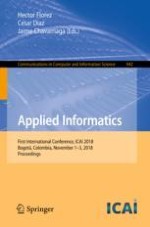2018 | Buch
Applied Informatics
First International Conference, ICAI 2018, Bogotá, Colombia, November 1-3, 2018, Proceedings
herausgegeben von: Hector Florez, Cesar Diaz, Jaime Chavarriaga
Verlag: Springer International Publishing
Buchreihe : Communications in Computer and Information Science
